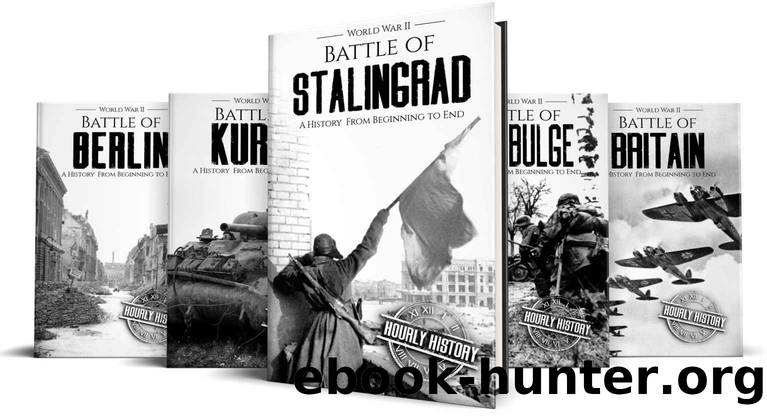World War II Battles: The Greatest Battles that Defined World War II by Hourly History

Author:Hourly History [History, Hourly]
Language: eng
Format: epub
Published: 2019-10-21T00:00:00+00:00
Chapter Four
The Soviet T-34
âThe finest tank in the world.â
âGerman Field Marshal Ewald von Kleist
Hitler went into Operation Barbarossa with a sense of certainty that this was the end of the Soviet Union. He had insisted in Mein Kampf that âthe end of the Jewish domination in Russia will also be the end of Russia as a state.â The victory of the blitzkrieg assault on Europe was further proof that the superior German could easily defeat the inferior Slav. For Hitler, whose belief in racial purity was a driving factor in his war planning, this perspective guaranteed that Russia would be enslaved by the superior German forces.
The invasion of the Soviet Union began at three oâclock in the morning on June 22, 1941. In less than three weeks, the Germans had captured 300,000 Russian soldiers. They had been equally successful with Soviet weaponry, capturing or destroying 2,500 tanks and 1,400 artillery guns and 250 aircraft. The result was overwhelming, a continuation of the swift victories that they had enjoyed in their previous European campaigns. It was also ultimately catastrophic because the units had moved faster than the armyâs supply and communication lines could keep up.
Perceiving an easy victory, Hitler ordered Panzer groups to move southeast to Kyiv and to the north, depriving the Army Group Centre of a pair of its most effective forces. But who was going to disagree with Hitler, even if the tactic meant that, despite its success, the military was losing time? When his commanders reminded him of the reputation of the Russian winter, Hitler was dismissive, replying âOne canât put any trust in the meteorological forecasts.â Hitler was confident that by the time October arrived, Operation Barbarossa would be successfully concluded and Russia would have fallen.
By the time October 1941 came and the temperatures were dropping, the Germans had limited clothing to ward off the cold and no antifreeze for their vehicles. The Russians, on the other hand, knew their climate and their soldiers dressed for it, with lined boats and heavy coats designed to protect against the freezing weather. The Russians had another advantage in addition to the winter: Stalin had no intention of allowing his Red Army to give in, and the military feared Stalin much more than they feared the Germans. As soldiers died, more took their place; by the time 1941 came to a close, Stalin had added 290 more divisions and 1.25 million more men. Germany had expected to encounter 4.2 million Soviet soldiers, but by the time of the attack, the Soviets were waiting with 5 million men. Nonetheless, Soviet casualties were immense, with a loss of 3.4 million by death, wounds, and capture as prisoners of war by the end of 1941.
In order to replenish their front lines quickly, the Red Army added women to the fighting units. During the time of the German invasion, one million women took their places on the front lines, serving as fighter pilots, anti-aircraft gunners, and partisan guerillas. The women, dedicated and intent on winning, were able to boost the morale of the Soviet military.
Download
This site does not store any files on its server. We only index and link to content provided by other sites. Please contact the content providers to delete copyright contents if any and email us, we'll remove relevant links or contents immediately.
| Africa | Americas |
| Arctic & Antarctica | Asia |
| Australia & Oceania | Europe |
| Middle East | Russia |
| United States | World |
| Ancient Civilizations | Military |
| Historical Study & Educational Resources |
The Light of Days by Judy Batalion(1067)
First Platoon: A Story of Modern War in the Age of Identity Dominance by Annie Jacobsen(904)
Stalin's War: A New History of World War II by Sean McMeekin(863)
The Pacific War 1941-1943 by James Holland(803)
Walk in My Combat Boots by James Patterson(766)
The American War in Afghanistan by Carter Malkasian(744)
Victory's Price (Star Wars) by Alexander Freed(735)
The Vietnam War: An Intimate History by Geoffrey C. Ward & Ken Burns(724)
Blood and Ruins: The Great Imperial War, 1931-1945 by Richard Overy(688)
Operation Pedestal by Max Hastings(683)
Concepts of Space by Jammer Max;(667)
Cold War (Alexander King Book 2) by Bradley Wright(663)
Extreme Fitness by Chris McNab(654)
The Madman Theory by Jim Sciutto(652)
Flying Tiger by Samson Jack(637)
World War II Infantry Fire Support Tactics by Gordon L. Rottman(613)
Pathfinders by AL-KHALILI JIM(611)
Panzerkrieg by Mike Syron(601)
Hitler’s Pre-Emptive War: The Battle for Norway, 1940 by Henrik O. Lunde(586)
